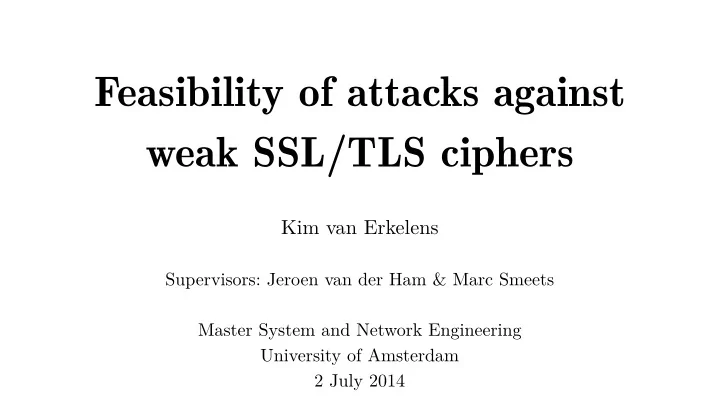

Feasibility of attacks against weak SSL/TLS ciphers Kim van Erkelens Supervisors: Jeroen van der Ham & Marc Smeets Master System and Network Engineering University of Amsterdam 2 July 2014
Introduction Motivation • Ciphers like DES and RC4 are considered weak • Weak ciphers still widely used • No practical feasibility of attacks described SSL Pulse 2
Introduction Previous Research • Minimal Key Lengths for Symmetric Ciphers to Provide Adequate Commercial Security • Yearly Report on Algorithms and Keysizes • SSL/TLS: What’s Under the Hood 3
Introduction Research Questions What is the feasibility of cracking weak ciphers based on resources required? 1. Which SSL/TLS ciphers are considered weak? 2. How can intercepted tra ffi c be decoded and which tools can be used? 3. What are the requirements? 4. How can the attack be classi fi ed based on time, money, and resources? 4
Background TLS and RDP • TLS = Transport Layer Security • Applications: HTTPS, SMTP, RDP etc. • RDP = Remote Desktop Protocol • Standard and Enhanced Security (uses TLS) • Open speci fi cation 5
Background RDP Stack Kerberos / NTLM RDP CredSSP Transport and Communication TLS TLS TCP TCP User authentication RDP data
Methodology Decoding Tra ffi c 1. Obtaining session or private key • Exhaustive key search • Crypto-analytical attacks • RSA factorisation 2. Decryption using private key or session key 7
Methodology Experimental Setup • Virtual servers: • Ubuntu with Apache and mod_ssl • Windows Server 2003, 2008 & 2012 • Known private and session keys are used • HTTPS • RDP Enhanced Security • RDP Standard (di ff erent encryption levels) 8
Methodology Tools • openssl : enforce cipher suite • tcpdump : tra ffi c capture • Wireshark : decryption and analysis • Mimikatz : export Windows Server private key 9
Methodology Decryption with Wireshark
Methodology Classi fi cation • Budgets ranging from $400 - $300M • 56-bit : $750 in 30 days (2008) • Attack can be realised in d/w days by a device costing cw dollars • i.e. larger budget results in shorter recovery time • Application of Moore’s law: cost of attack drops by a factor 2 every 18 months
Findings Weak Cryptography • Cipher suites with key sizes smaller than 128 bits • 3DES (< 128 bits of security), EXPORT cipher suites • Ciphers with cryptographic weaknesses • RC4 (statistical biases in the key table) • RSA keys with short moduli 12
Findings Decryption source: fail0verflow userName: 410064006d0069006e006900730074007200610074006f00... (Administrator) password: 700061007300730077006f00720064000000 (password) clientInfoPDU
Findings Requirements • Tra ffi c can’t be decrypted with private key for: • Di ffi e-Hellman (DHE) key exchanges • Ephemeral suites • Whole session is captured • Correct format RSA key fi le • Correct format session key (master secret) 14
Findings Practical Feasibility Feasible • Exhaustive key search: 40 or 56-bit session key • RSA factorisation: < 512-bit modulus Less feasible • Crypto-analytical attack on RC4: ( 13 * 2^20 sessions needed) 15
Conclusions Conclusions • Attacks are feasible for short key lengths • Crypto-analytical attacks are less feasible • HTTPS and RDP (standard & enhanced) decryption possible • RDP requires more e ff ort for extracting information 16
Conclusions Future Work • Decompression of RDP tra ffi c and extraction of information • Decryption without Session ID • Other applications with TLS 17
Questions? 18
Recommend
More recommend